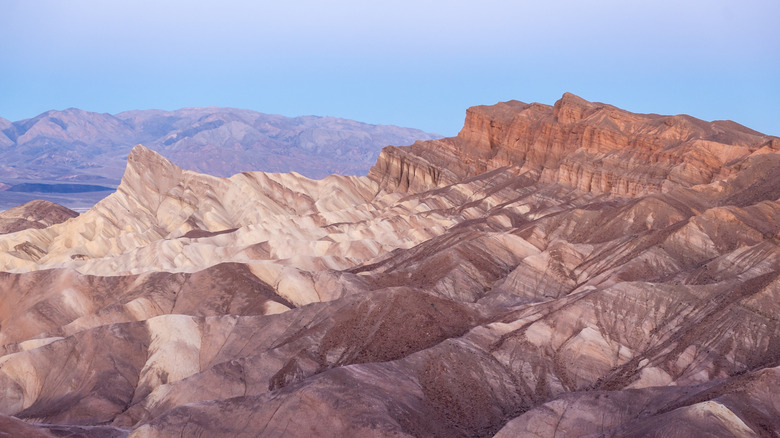Everything You Need To Know For A Safe Road Trip Through Death Valley
We may receive a commission on purchases made from links.
In the arid, empty planes of Southeastern California, you'll find one of the hottest places on earth, Death Valley. The 140-mile-long desert with blistering temperatures and sci-fi landscapes has truly earned its name. Claiming an estimated 68 lives from heat-related complications, road accidents, and other natural causes between 2007 and 2024, to venture into Death Valley can be to play with death itself.
Death Valley was proclaimed a national monument by President Hoover in 1933, an act which set forth to preserve its 2 million acres of land for scientific and scenic interest. Hoover recognized that this sprawling badlands had, and still has, some of the best desert landscape views in America. So if you're finally taking the West Coast bucket-list road trip through Death Valley's desolate, rugged landscape, you're sure to see some of nature's finest offerings on the way. With its sand dunes and salt flats, the barren wasteland of Death Valley is a bleak but beautiful cinematic backdrop that has featured in iconic movies such as the original "Star Wars" trilogy. It's also a perfect destination for unobstructed views of the Milky Way.
Offering quintessential desert views and incredible sunsets, this destination draws over a million intrepid visitors a year. However, make sure to be prepared for your road trip, as getting stranded in the heat or a flash flood or accidentally wandering into an illegal marijuana grow site can have serious consequences.
Pack for the heat
In 1913, at a soaring 134 degrees Fahrenheit, Death Valley recorded the highest temperature ever seen on Earth. This record still prevails today, making this desert a legendary global hotspot that is sure to keep getting hotter as global temperatures rise. The heat has been known to claim lives, so from the offset, you should be thoroughly prepared for the soaring high temperatures. Obviously, staying hydrated throughout the day is of extreme importance, so make sure you keep lots of water in the car and refill your bottles at every opportunity.
If you plan to do some hiking on your road trip, wearing protective clothing such as sun hats and breathable, long-sleeved shirts and pants is encouraged. Make sure to stay on alert for the symptoms of heat fatigue (aka heat exhaustion), such as nausea, vomiting, headaches, and cramps as it can quickly develop into heat stroke with more serious symptoms such as confusion, disorientation, and changes to regular behavior. In serious cases, heat stroke can prove fatal.
For this reason, you should avoid hiking during heatwaves, or stick to the valley's mountain ranges where the temperatures remain cooler. Aside from the heat, the expanse means that there is sometimes limited-to-no cellphone access in the desert, so make sure to travel with a paper map alongside your online maps in case of reception failure. Taking extra supplies such as food, water, and blankets on your trip in case of getting lost is also highly advised. For extra safety, some seasoned hikers carry spot devices, satellite phones, and flares in case they become stranded. In emergencies, you can contact the park ranger, call 911, or head to Furnace Creek Visitor Center for information and assistance.
Preparing for the unpredictable
Death Valley is a law unto itself, and it's important to remember that nature rules the landscape. When driving, make sure to comply with the stated speed limits as most of the deaths in the Valley have been caused by car accidents on its winding roads. In some parts of the valley, the roads veer off into steep inclines, which can be challenging to navigate if you're driving too fast. Wearing seatbelts is not only the law in California, but can protect you in the event of a car accident. It's also wise to plan regular rest stops along your road trip route and swap drivers when possible to break up long stretches.
The roads aren't the only unpredictable part of the valley. Though Death Valley doesn't see much rain, storms can appear out of nowhere and can rapidly develop into flash floods. These floods can become so powerful that they can carry tree branches, rocks, and debris at very fast speeds, and can therefore become extremely dangerous for hikers. If you are hiking and get caught in a rainstorm or flash flood, make sure to head for high ground as soon as you can. Another thing to be wary of while hiking through Death Valley is that there may be illegal marijuana grow sites in the area. If you find yourself on what you suspect to be one of these grow sites, turn around immediately, and make sure to prioritize your safety. With all this in mind, make sure you leave nature untarnished by taking all your trash with you when you leave and don't forget to prepare that extra-long playlist for what might be the drive of a lifetime.


